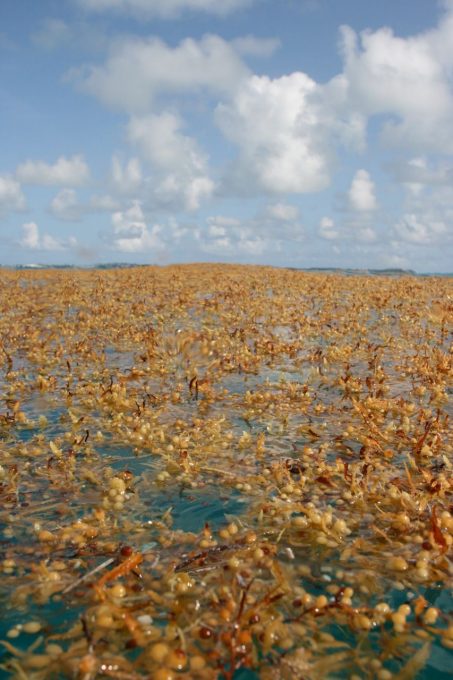For almost ten years, coastal resorts and communities in the Caribbean and Gulf of Mexico region have been blindsided by the problem of rotting sargassum washing up to shore, threatening ecosystems and local economies. This is a new-natural phenomenon which results from two things which have been impacting the world for decades: climate change and man-made destruction.
Sargassum is an abundant and ecologically important type of algae that originates in the Northern Atlantic Subtropical Gyre, called the Sargasso Sea. Floating islands of this seaweed provide safe haven habitats for endangered eels, turtle hatchlings, and some crustacean species, among others. A buoyant plant for the duration of its life, when sargassum dies it drops to the ocean floor where it provides carbon energy to other organisms. This cycle is a beneficial part of the oceanic circle of life, but the ability to reproduce through fragmentation has been a primary source of concern, as the population grows rapidly without disturbance. Recently, this uncontrollable growth has caught the attention of scientists and Caribbean beach-goers alike.
The arrival of sargassum is not generally uncommon to beach areas, but in 2011, unusually large amounts started washing up on shore. Using infrared tracing via satellites, two scientists at the University of South Florida saw the migration of this seaweed, away from the Sargasso Sea, and up through the northern part of South America into the Mexico region. Dense quantities of algae made their way to beaches, continually exacerbating a growing crisis and causing a state of emergency in some regions.
Tourism – of course – is a necessity to the Gross Domestic Product (GDP) of Mexico and the Caribbean, generating 14% and 17% respectively, bringing in billions of dollars annually. The sargassum influx has been highly detrimental to this industry since 2011, and especially noticeable in 2015 and 2018 when large blooms took over the region’s beaches.
The related decline in tourism was harming to local economies even before Covid arrived; whilst environmentally speaking, this sargassum explosion could create immense long-term problems. Normally a healthy part of ocean life, increasing quantities of sargassum threaten both ocean and human life. Thickening mats of this algae block the sun from reaching coral reefs, leading to the decay and death of these structures, while rotting sargassum creates an increase in nitrogen and phosphorus levels in underwater communities. This process could lead to contamination of groundwater; areas that rely on natural groundwater, such as the Yucatan Peninsula, will likely suffer from pollution of drinking water and decreased quality of life.
The eroding beaches and long-term economic problems are not a coincidence; they are a culmination of human recklessness; deforestation in the Amazon rainforest has long been documented, and is a key contributor to the seaweed problem. Pesticides and fertilizers runoff into the Amazon and Congo rivers have accumulated in the waters between Brazil and Africa and contributed to a faster sargassum growth rate, creating a new origin for this algal species. To make matters worse, global temperatures have risen just over one-degree Fahrenheit every 10 years; the increased warmth being a catalyst for sargassum reproduction. This growth, decay, and destruction of life is just one example of the problem of human interference in nature: a seemingly small change that contributes to lasting, large-scale challenges.
Clean-up efforts have ranged from manual labor with rakes and backhoes, to the purchase of heavy machinery and installation of floating barriers, but the invasion is near impossible to stop. Between the months of May and September alone, over 13,000 tons landed on the Quintana Roo coast, spanning 1176 Kilometers. There is a need to abstract it from beaches, but Gerardo Peña, a Biologist with nonprofit Ninth Wave Global, explains that the bigger issue is not just collecting it, “it’s processing it and reintegrating it back into the environment.”
Scientists in the Yucatan Peninsula are attempting to maximize sargassum recycling in two ways: converting it into electricity and using it as a fertilizer for vegetation, such as mushrooms. Peña says that some efforts of re-issuing sargassum include creating notebooks, shoes, and bricks for sustainable building. “But let’s face it,” said Peña, “without an industrial process, it’s just impossible to manage.”
These are temporary solutions, but a conscious environmental focus and a commitment to addressing climate change would be a start towards generating the necessary intellectual and practical infrastructure necessary to coherently focus on current and future problems.
For Times Media Mexico
Dylan Volpintesta in Philadelphia



